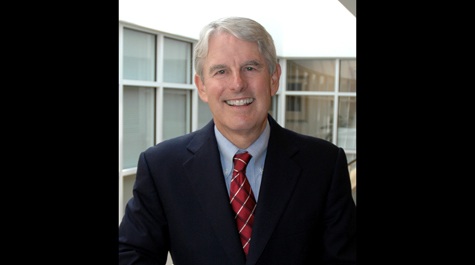Hobson to Publish St. George Tucker Papers
"His profession was law," Hobson said, "but the law was only one facet of the multifaceted life he led." In addition to being a law professor, judge, and legal commentator, the many-talented Tucker was a poet, playwright, essayist, scientist, inventor and horticulturist.
"Even in the area of law," Hobson said, "Tucker's legacy has not been fully appreciated. This is particularly true of the massive collection of his law papers that have reposed in Swem Library's Special Collections since 1938." After completing the twelfth and final volume of The Papers of John Marshall (University of North Carolina Press, 2006), Hobson tackled the monumental task of researching and annotating Tucker's legal manuscripts.
The heart of the collection is a set of law reports that Tucker entered into 33 notebooks, totaling 1,600 pages. He bound these notebooks into three manuscript volumes, which he titled "Notes of Certain Cases in the General Court, District Courts, and Court of Appeals in Virginia, from the year 1786 to 1811". Tucker also compiled three additional notebooks of cases in the U.S. District Court and the U.S. Circuit Court from 1813 to 1822.
"Publication of Tucker's law reports is well overdue," Hobson said. And he is well on his way to bringing this project to fruition.
Tucker arrived in Virginia from Bermuda in 1771 and entered the College of William & Mary in 1772 where he studied general academics in the schools of natural and moral philosophy. He then read law under George Wythe, and was admitted to the bar of county courts in 1774 and of the General Court in 1775. His law career was interrupted by the American Revolution, but after the war he established a busy practice in the county courts around Petersburg. By the mid-1780s he was attending the superior courts in Richmond. Tucker succeeded Wythe as Professor of Law in 1790, and in 1804 he was promoted to the Virginia Court of Appeals. In 1813, he accepted President James Madison's appointment as a U.S. District Court judge. There Tucker also sat with Chief Justice John Marshall on the U.S. Circuit Court for Virginia. He tendered his resignation in 1825, two years before his death.

Tucker conducted his law classes in between judicial sessions, basing his course around William Blackstone's Commentaries on the Laws of England. He took great care to point out the differences between English law and Virginia and American practice, which required modifying or discarding Blackstone at many points. Tucker incorporated his lecture notes into his edition of Blackstone, published in 1803, entitled Blackstone's Commentaries: With Notes of Reference, to the Constitution and Laws, of the Federal Government of the United States; and of the Commonwealth of Virginia.
This is the work for which Tucker is best known among American lawyers today. Tucker's Blackstone was a leading law text of its day and the first commentary on the U.S. Constitution after the Federalist Papers, said Hobson. It has been reprinted as recently as 1996, and is available in several online versions. Tucker's work is still cited and quoted in U.S. Supreme Court opinions, most recently in the Second Amendment gun case, District of Columbia v. Heller.
At this point in the project, Hobson has 2,600 pages of typescript that include 3,000 notes with multiple citations. He is now revising and collecting information to write the general introduction to the edition. Also included in the publication will be a full bibliography and biographies of more than 100 members of the bench and bar of Virginia during Tucker's time. A glossary of terms and other information are also planned. Publication is tentatively scheduled for the fall of 2011.
Funding for Hobson's work is derived from several grants from the National Endowment for the Humanities, the National Historical Publications and Records Commission, the William Nelson Cromwell Foundation, and the Warren W. Hobbie Charitable Trust. Other contributions have been made to the project by the Roller-Bottimore Foundation, Richard and Caroline T. Gwathmey Memorial Trust, and the Earhart Foundation, as well as from the College and the Law School. Hobson has been assisted in this endeavor by Managing Editor Joan S. Lovelace who also worked on the Marshall papers.
Prior to coming to William & Mary in 1979, Hobson was at the University of Virginia, where he edited several volumes of The Papers of James Madison. He is the author of The Great Chief Justice: John Marshall and the Rule of Law (University Press of Kansas, 1996), editor of John Marshall: Writings (The Library of America, 2010), and served as the President of the Association for Documentary Editing in 1996.
Tucker's legacy also endures in the 18th-century house bearing his name in Colonial Williamsburg's Historic Area, where visitors can learn more about his life and contributions to the new nation's legal system. The Tucker Law Papers will provide important information not only for historians and legal scholars but also for the general public who visit his Williamsburg home.
